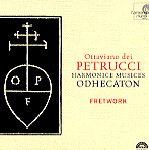Ottaviano Petrucci (1466-1539) was not a composer but a music printer, the first to print part-music, using a three-impression process that he developed. He’s best known for publishing the huge three-volume collection of polyphonic chansons known as Harmonice Musices Odhecaton. The viol consort Fretwork performs a selection of 32 of these sophisticated pieces, which vary in texture and complexity but always maintain an easily discernable connection to their roots in song. The quality of the music–some of the original tunes will be familiar to serious early music listeners who’ve heard them used in other settings–is not so surprising owing to origins from the pens of composers such as Busnois, Ockeghem, Obrecht, Isaac, and Josquin. Fretwork applies its considerable knowledge of style and its well-seasoned ensemble sensitivity to create not only a beautiful sound–sumptuous, tart, and reedy–but ongoing little dialogues between and among the instruments. The liner notes give important background on how composers used the various tunes and how different voices were added and transformed–but these are details that, while fascinating and useful for more serious observers, aren’t necessary to know in order to appreciate the melodic loveliness of a piece such as Japart’s five-part “Vray dieu d’amours” or the infectiously rhythmic character of Josquin’s “De tous biens playne”. The sound, from England’s Forde Abbey, gives the instruments ideal space to naturally resonate and blend, and places the listener in a perfect spot to obtain both detail and to enjoy the richness of the full ensemble textures. Highly recommended.
































